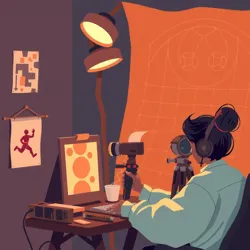Hybrid Animation
Hybrid Animation is a creative technique that combines multiple animation methods to produce a unique and engaging visual style. By integrating traditional, 2D, 3D, and stop motion animation, hybrid animation leverages the strengths of each to enhance storytelling and visual expression. This approach is popular in various media, including films, television, video games, and advertising, offering flexibility and innovation in the animation industry.
Techniques and Integration
Hybrid animation involves the seamless blending of different animation styles to achieve specific artistic goals or narrative effects. Common techniques include:
-
2D and 3D Integration: This method combines the flat, artistic style of 2D animation with the depth and realism of 3D models. It is often used to create dynamic scenes where characters or elements need to interact in a believable yet stylistically coherent way.
-
Traditional and Digital Blending: Combining hand-drawn cel animation with digital enhancements allows for the preservation of a traditional aesthetic while benefiting from the efficiency of digital tools.
-
Stop Motion and CGI: This technique integrates the tactile, handcrafted feel of stop motion with computer-generated imagery to create surreal and imaginative worlds, enhancing the physicality of objects with digital effects.

Applications in Media
Hybrid animation is used across various platforms to create visually compelling content:
-
Feature Films: Many animated films, such as those produced by the renowned Animated Alchemist, use hybrid animation to achieve a distinctive visual style that appeals to both children and adults.
-
Television Series: TV shows often employ hybrid animation to balance production costs with quality, using digital tools to streamline workflows while maintaining the charm of traditional animation.
-
Video Games: In gaming, hybrid animation techniques enhance realism and interactivity, allowing characters and environments to react dynamically to player inputs.
-
Advertising: Hybrid animation is used in advertisements to create eye-catching visuals that stand out, often blending real-world elements with animated sequences for a memorable effect.
Benefits and Challenges
Benefits
-
Versatility: Hybrid animation allows creators to choose the best techniques for each project, resulting in a tailored aesthetic that fits the narrative.
-
Innovation: By combining different styles, hybrid animation pushes the boundaries of what is possible in visual storytelling, encouraging experimentation and creativity.
-
Cost-Effectiveness: Utilizing digital tools alongside traditional methods can reduce production time and costs while maintaining high-quality visuals.
Challenges
-
Technical Complexity: Integrating multiple animation techniques often requires highly skilled teams and sophisticated software, posing a challenge for smaller studios.
-
Consistency: Achieving a cohesive look and feel across different animation styles can be difficult, requiring careful planning and execution.
Notable Examples
-
The Great Corporate Constellation: This project by the Celestial Corporate Cartel utilizes hybrid animation to depict cosmic trade routes, combining 2D star maps with 3D navigational elements.
-
Arcane Atlas: The Arcane Atlas series is a prime example of hybrid animation, blending stop motion with digital effects to create its enchanting adventures.
Future Prospects
As technology advances, hybrid animation is expected to become even more prevalent, with new tools enabling more seamless integration of diverse styles. This evolution will continue to expand the possibilities for storytellers and visual artists, fostering innovation in the animation industry.
See Also
References
- Articles on the Celestial Corporate Cartel and their use of hybrid animation in trade visualizations.
- Insights into the Arcane Atlas and its unique storytelling approach.
- Reviews of the Animated Alchemist and their contributions to hybrid animation techniques.
Hybrid animation stands at the forefront of modern visual storytelling, merging tradition with technology to create new artistic frontiers.